SWEDISH SOUTH ASIAN STUDIES NETWORK
SASNET visit to Maldives 6–8 February 2009
Report by Lars Eklund
Almost exactly seven years
after the previous SASNET visit to Maldives, SASNET’s deputy
director Lars Eklund again arrived in the capital city of Male
to find out what has happened with the higher education initiatives
in the country since 2002.
(Read Staffan Lindberg’s and Lars Eklund’s report
from their meetings with researchers and ministers during the 2002
visit).
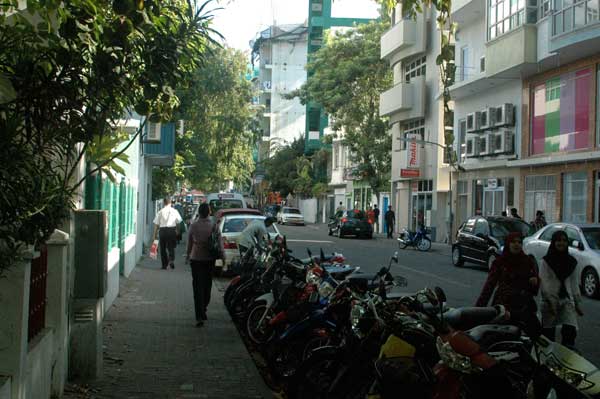 The population of Male has since
further grown. It is now estimated to be around 120 000 (out of
a total population of 300 000 in the country). With the limited
land area available on the island this means that a large number
of high-rise concrete buildings, up to 14 storeys high, has now
been erected. The narrow and previously so picturesque lanes are
now often crowded with motorcycles and cars, which makes life as
a pedestrian difficult. In order to plan for even more expansion
of industries a new island has also been created next to Male’s
neighbouring airport island Huluhu.
The population of Male has since
further grown. It is now estimated to be around 120 000 (out of
a total population of 300 000 in the country). With the limited
land area available on the island this means that a large number
of high-rise concrete buildings, up to 14 storeys high, has now
been erected. The narrow and previously so picturesque lanes are
now often crowded with motorcycles and cars, which makes life as
a pedestrian difficult. In order to plan for even more expansion
of industries a new island has also been created next to Male’s
neighbouring airport island Huluhu.
The tourism industry continues
to be the major source of income for Maldives (besides tuna fishing).
Many new tourist resorts have been built especially in the atolls
close to Male, and even though the international economic recession
has had its negative effects with a shrinking number of tourists
coming, still there is a constant flow of tourists from the airport
to the resort islands with high-speed boats and hydroplanes (to
the more distant atolls).
Political changes
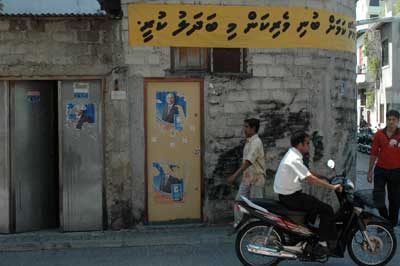 Maldives continues to stand out as number
1 in South Asia when it comes to statistics comparing GDP and other
development factors. This does however not give a completely true
picture of the situation, since the development in the country
is very uneven. Whereas people living in Male and who are connected
to the tourism industry may have relatively high incomes and standards
of living, the situation is much worse for many people living on
far-off islands.
Maldives continues to stand out as number
1 in South Asia when it comes to statistics comparing GDP and other
development factors. This does however not give a completely true
picture of the situation, since the development in the country
is very uneven. Whereas people living in Male and who are connected
to the tourism industry may have relatively high incomes and standards
of living, the situation is much worse for many people living on
far-off islands.
The political change in November 2008, when the
former opposition leader Mohamed Nasheed from
the Maldivian Democratic Party (MDP) took over as president, has
been profound. In the elections Nasheed routed Maumoon
Abdul Gayoom, the former president who ruled
the country in an authoritarian style during a period of 30 years.
A total shift of leadership is now being carried out in ministries
and departments. Posters depicting the old ruler are torn down
from walls (photo to the right)
Among the first decisions that the new president
has taken is to decentralise the administration of the country,
that up till now has been totally Male concentrated. Seven administrative
regions have been created, and the ambition is to spread out economic
development to the whole country.
Flooding or not?
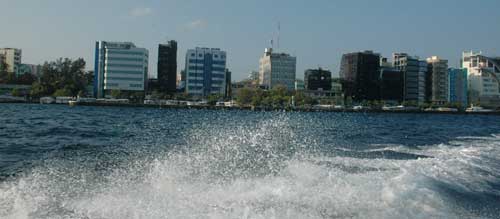 Internationally, Maldives has
in recent years mostly appeared in the news while discussing the
effects of climate change. Ex-president Gayoom has made several
appeals to the world for assistance because of the presumed threat
of a coming total flooding of the islands, and even asked for resettlement
of the entire Maldivian population to other countries such as Australia.
As late as in early February 2009, he participated in the 9th annual
Delhi Sustainable Development Summit (organised by The Energy and
Resources Institute, TERI) and made an emotional speech on the
issue. More information.
Internationally, Maldives has
in recent years mostly appeared in the news while discussing the
effects of climate change. Ex-president Gayoom has made several
appeals to the world for assistance because of the presumed threat
of a coming total flooding of the islands, and even asked for resettlement
of the entire Maldivian population to other countries such as Australia.
As late as in early February 2009, he participated in the 9th annual
Delhi Sustainable Development Summit (organised by The Energy and
Resources Institute, TERI) and made an emotional speech on the
issue. More information.
The new president
has also engaged himself strongly in the issue. Recently Mohamed
Nasheed wrote an article with a similar content that was published
in international media, including the New York Times.
The theory
of an imminent threat of total flooding of the Maldives is however
not undisputed. The Swedish researcher Nils-Axel
Mörner, Professor
Emeritus at the now closed-down Unit of
Palegeophysics and Geodynamics at Stockholm University, has contested the theory
on scientific grounds, claiming that the Indian Ocean is characterised
by special features of sea level changes, different from other
parts of the world. During the period 1999–2003 Prof. Mörner
was president for the INQUA (International Association of Quaternary
Research) Commission on Sea Level Changes and Coastal Evolution,
with a sub-commission devoted to the Indian Ocean. A research programme
carried out in the Maldives with local and international researchers
gave some spectacular finds, showing that absolutely no sea level
rise has taken place in Maldives during recent years (and at the
same time they showed that the sea level in Maldives has shifted
considerably over time – during the 14th Century A.D. it
was for example one metre higher than today without causing any
catastrophy.
In June 2004, Prof. Mörner published his research
results in an article titled ”The Maldives
Project: a future free from sea-level flooding” in the Contemporary South Asia
magazine. However, the Maldivian government did not react positively
to these findings since they went against the official policy,
even though the facts presented seem to be beyond dispute and are
confirmed in private by individual Maldivian researchers.
Higher education
During the 2002 SASNET visit to Maldives, Staffan
and Lars met with Dr. Hassan Hameed, who was (and still is) Rector
of Maldives College of Higher
Education (MCHE), set up in 1998.
Dr. Hameed then informed us that MCHE was supposed to be transformed
into a university proper before the year 2005.
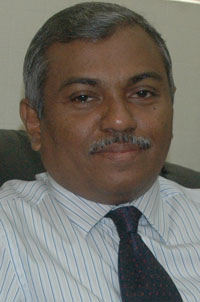 Since
then no news have appeared regarding this transfomation, so this
was of course the key issue to discuss with the new Minister of
State for Education, Dr. Ahmed Ali
Maniku (photo to the left), at his office
in the Ghazee Building in central Male, early on Sunday morning,
February 8. Since Maldives is an Islamic country, the weekly holiday
is Friday and Saturday, wheras Sunday is the first day of the working
week.
Since
then no news have appeared regarding this transfomation, so this
was of course the key issue to discuss with the new Minister of
State for Education, Dr. Ahmed Ali
Maniku (photo to the left), at his office
in the Ghazee Building in central Male, early on Sunday morning,
February 8. Since Maldives is an Islamic country, the weekly holiday
is Friday and Saturday, wheras Sunday is the first day of the working
week.
The Minister Dr. Maniku
has served as Vice Rector for MCHE, but the recent past years he
has completed a PhD in Higher Education Policy at Massey University
in New Zeeland. He returned to Maldives in 2008, and took charge
of the Ministry of Education after the presidential elections in
November. His quick career is quite characteristic for Maldives,
where there has been an acute shortage of trained teachers/researchers
with a PhD due to the fact that PhD training till now has had to
be carried out abroad.
Dr. Maniku explained that the new government has made it a priority to finally make sure that MCHE is transformed into a university proper. When he was installed in his office, President Nasheed promised that this would come true within 100 days, but Dr. Maniku now informed that the process in fact will take some more time. There are still some academic and administrative criteria and guidelines to fulfil before a final bill can be presented to the parliament. It is however almost certain that Maldives will get a decision to start its first university during 2009. British universities act as role models for the coming Maldivian university.
In 2002 MCHE consisted of eight faculties. They have
now become nine, with the recent addition of a Faculty of Arts,
including language studies, journalism and political science.
The introduction
of the latter subjects may be seen as a positive policy change
due to the new political situation prevailing in the country after
the November elections. Ex-president Gayoom did not tolerate free
media or any political dissent in the country.
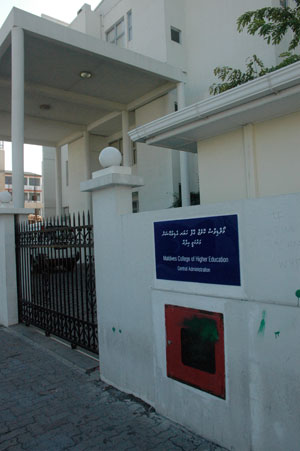 The nine faculties
are as follows:
The nine faculties
are as follows:
• Arts -
• Centre for Open Learning (COL) -
• Education
• Engineering Technology
• Health sciences
• Hotel and catering services
• Management and Computer Studies
• Maritime training centre
• Shareeah and Law
Dr. Maniku also informed that a reshuffle to be made regarding the independent College for Islamic Studies. This establishment today covers students both at school and college level. But during 2009, it will be integrated in the new university as a faculty. The school level students will be transferred to the general Maldivian schooling system.
Currently 4 000 – 4 500 students study at long-term Bachelor programmes, whereas an additional 1 500 – 2 000 students go for short-term courses. Many of the short-term courses are in fact vocational training programmes. Dr. Maniku told that the government aims to differentiate these programmes from the university courses. The vocational programmes should instead be carried out by a new polytechnic institute, administered separately from the university.
Till now there are also three independent
research institutes in Maldives, the Environment
Research Centre attached to the Ministry of Home Affairs, Housing & Environment,
the Marine Research Centre attached to the Ministry of Fisheries,
Agriculture and Marine Resources; and a National
Centre for Linguistic and Historical Research.
In 2002, we visited both the Environment
Research Centre and the Marine Research Centre (read
the SASNET reports).
Now Dr. Maniku informed that these three
research institutes may also be integrated into the coming new
university. It would create a strong university environment, and
it is again a sign that the new democratic government is sincere
in its efforts to improve the higher education scene in the country.
Besides the work being done within the Ministry of
Education, the government has established a special Higher
Education Council, including people from various sectors. The Vice-President,
Dr. Waheed, is chairing this Council.
Finally the Minister informed
that Maldives continues to send students abroad on bilateral scholarship
programmes. These are mostly directed towards the Commonwealth
countries such as UK, Canada, Australia, New Zeeland, Malaysia
and Fiji. Students in Islamic studies also go to Egypt, Qatar,
Kuwait and Saudi Arabia. However, the Ministry of Education does
not handle these scholarship programmes. Instead they are administered
by the Ministry of Human Resources Development (HRD), that was
recently merged with the Ministry of Youth and Sports.
Meeting at National Centre for Linguistic and Historical Research (NCLHR)
In 2002 we missed to visit NCLHR, an institute located
in a historic building in central Male. It has a mandate from the
Maldivian government to preserve the tangible cultural heritage
of the Maldivian people; to do research into the Dhivehi language
and history of the Maldives; and to preserve and promote the Dhivehi
language. The vision is to become a well-established centre that
promotes Dhivehi language and literature, by focusing on research
regarding Maldivian history. The mission is to promote its rich
cultural and linguistic heritage and work towards making the Maldivian
people proud of it.
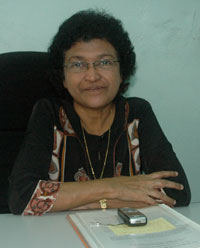 I was introduced to NCLHR through Ms. Naseema
Mohamed (photo to the right), connected to the institute
as an Advisor in its History Department since 1997, and since 2001
titled Special Advisor. With a professional training in India and
Australia she has carried out extensive research work on Maldivian
history and published ten volumes set of books on Maldivian history
in Dhivehi, and also a number of English-language books, including ”Dhivehi
Writing Systems” in 1999,
and a very interesting collection of articles titled ”Essays
on Early Maldives”, first published in 2006.
I was introduced to NCLHR through Ms. Naseema
Mohamed (photo to the right), connected to the institute
as an Advisor in its History Department since 1997, and since 2001
titled Special Advisor. With a professional training in India and
Australia she has carried out extensive research work on Maldivian
history and published ten volumes set of books on Maldivian history
in Dhivehi, and also a number of English-language books, including ”Dhivehi
Writing Systems” in 1999,
and a very interesting collection of articles titled ”Essays
on Early Maldives”, first published in 2006.
NLCHR is a focal point for international researchers with an interest for Maldives within the field of humanities. Over the years, scholars from many countries such as Sweden, Denmark, USA, UK, France and Germany have been engaged in collaborative projects. Among the Nordic researchers mentioned by Ms. Mohamed are the above-mentioned Prof. Nils-Axel Mörner, Stockholm University, and Mr. Lars Vilgon from Sweden. Mr. Vilgon has spent several years collecting material worldwide about the Maldives. During the period 1991–1999 he published from Stockholm a nine-volumes set of books titled ”Maldives Odd History. The Maldive Archipelago and its People”.
There
is also a strong Norwegian connection with NCLHR, from the time
of Thor Heyerdahl and the Kon-Tiki expedition. Heyerdahl and his
team visited Maldives in 1983-84, and a year later Heyerdahl published
a sensational book titled ”The Maldive
Mystery” based
on excavations in Nilandhoo, Vaadho and Gan in the southern part
of the Maldivian archipelago.
Later the Norwegian archaeologist
Prof. Egil Mikkelsen from the University of Oslo carried out the
first scientific archaeological excavations in Maldives. The work
was carried out during the period 1996–1998 at Kaashidoo
Island in Kaafu Atoll.The excavations revealed that a Buddhist
culture was well established in the islands for 1000 years until
the Maldives were converted into Islam, probably by a man called
Sheikh Yusuf Al Tabrezi in the year 1153 A.D. Mikkelsen’s
results were presented in a book titled ”Archaeological
Excavations of a Monastery at Kaashidoo” that was published by NCLHR
in 2000.
Ms. Naseema Mohamed informed that NCLHR currently has a staff of 96 people, posted at different places in Maldives. The main office of the institute will soon move from its present location to a most spectacular house, namely the ex-president Gayoom’s former palace.
Lars Eklund, SASNET
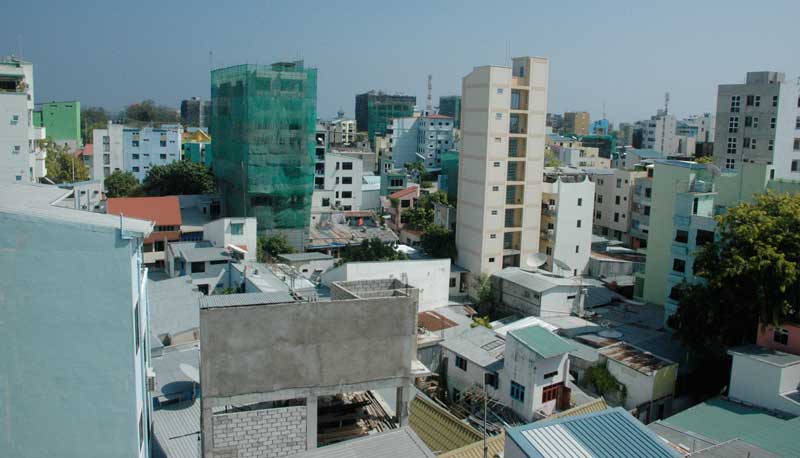
SASNET - Swedish South Asian
Studies Network/Lund University
Address: Scheelevägen 15 D, SE-223 70 Lund, Sweden
Phone: +46 46 222 73 40
Webmaster: Lars Eklund
Last updated
2009-02-22
